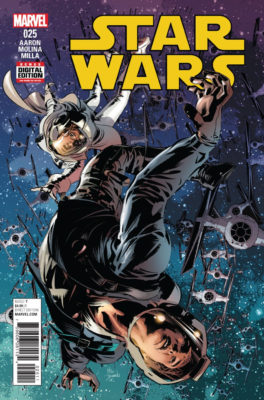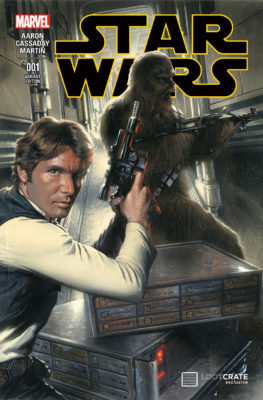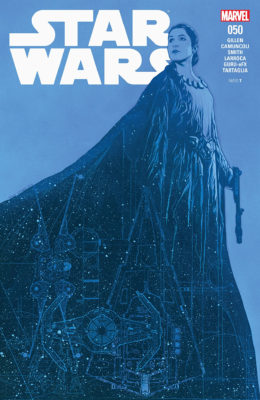Opinion: Marvel’s Main “Star Wars” Comic Needs to Catch Up to “The Empire Strikes Back”
In April of 1977, a month before the surprise smash hit original Star Wars film, the first issue of the Star Wars comic book was published by Marvel Comics. That series followed through for an additional 137 issues, adapting the movies A New Hope, The Empire Strikes Back, and Return of the Jedi in sequential graphic storytelling, while filling the gaps in-between with all-new stories, characters, and adventures.
A decade in, Marvel let its Star Wars license lapse due to lack of interest in the franchise in the late 1980s, then Dark Horse Comics picked it up in the early 90s with a string of successful sequels and spinoffs. Now, as of the beginning of 2015, the Lucasfilm license is back in Marvel's hands (under both company's new parent corporation Disney) and, in my opinion, has done an excellent job of completely rebooting their own corner of the current-canon Expanded Universe. Individual iconic characters such as Darth Vader, Han Solo, Princess Leia, Lando Calrissian, and even C-3PO have each been given their own titles, be they ongoing or in miniseries form. And a new character created for this run, namely the rogue archaeologist Doctor Aphra, has proven popular enough with fans to carry her own stories.
All that aside, I would like to take a moment to focus on the main title of Marvel Comics' present series of adventures set in a Galaxy Far, Far Away, named simply Star Wars. This comic once again follows the exploits of our heroes Luke Skywalker, Princess Leia Organa, and Han Solo as they evade the evil Galactic Empire, and is set between the events of Episodes IV and V of the larger Star Wars saga. Launching in January of 2015, this new run drew in some of Marvel's top writers and artists as they sought to reestablish what happened between the Battle of Yavin and the Battle of Hoth in the big tapestry of stories that makes up Star Wars. But therein lies the problem: nearly four years into this comic, too much has happened.Over more than four dozen issues, Luke and friends have clashed with the Empire time and again, visited a smuggler's moon, broken out of space jail, commandeered a Star Destroyer, visited a gothic horror-inspired Screaming Citadel, discovered the remnants of Jedha, honored the sacrifice of Jyn Erso, and are continually searching for a new hideout in the wake of Yavin. And as an occasional respite, the comic occasionally flashes back to the latter-day escapades of Jedi Masters Obi-Wan Kenobi and Yoda via Obi-Wan's journal entries which Luke recovered from Tatooine. But the repetitive nature of the main characters' travails is where I begin to take exception with the direction of this otherwise outstanding series.

With that in mind, I think it's about time the Star Wars comic book begins to steer its storyline toward the icy plains of Hoth and the beginnings of Echo Base, establishing a groundwork for the opening of The Empire Strikes Back. For all I know, this plan could very well already be in the works at Marvel. We did recently see Han run into a couple bounty hunters tracking him down for Jabba the Hutt, and though that wasn't on the planet Ord Mantell (as referenced in one of Empire's early scenes), the incident could indicate a step in that direction. But my guess is that the powers that be want to milk all they can out of the most famous Star Wars trio before they lose the character that makes this discussion such a tricky one: Han Solo himself.
As even the most casual Star Wars fan knows, near the end of The Empire Strikes Back Han Solo gets frozen in carbonite and placed under the guardianship of notorious bounty hunter Boba Fett. That development would take Han out of the running for being a major player in the Star Wars comic if and when it ever catches up to Empire, but that doesn't mean it's something Marvel should be afraid of. Solo may be one of the most popular characters in Star Wars history, but his absence would present a unique challenge to the book's writing staff, not to mention that it would likely inspire some unique and outside-the-box story choices. Marvel's run between Empire and Jedi in the early 80s was able to accomplish this, and that was without foreknowledge of how Lucas would wrap up Han's journey.There was even a multimedia event in 1996 called Star Wars: Shadows of the Empire that bridged the gaps between Episodes V and VI fairly well, though that undertaking relied on the introduction of a Han Solo stand-in named Dash Rendar. And since the vast majority of what occurs of those stories is no longer considered canon, Marvel (under the supervision of the Lucasfilm Story Group) has what amounts to a clean slate in deciding how Lando, Chewie, and the gang go about formulating their plan to rescue Han from Jabba the Hutt, and what happens to them in the meantime.
For the time being, I'm happy to continue reading most of Marvel Comics' Star Wars titles, and I'll cross my fingers that their creative teams know what they're doing and are willing to take bold leaps forward in their storytelling when the time is right. Until then, let's hope the Force continues to be with Marvel.




